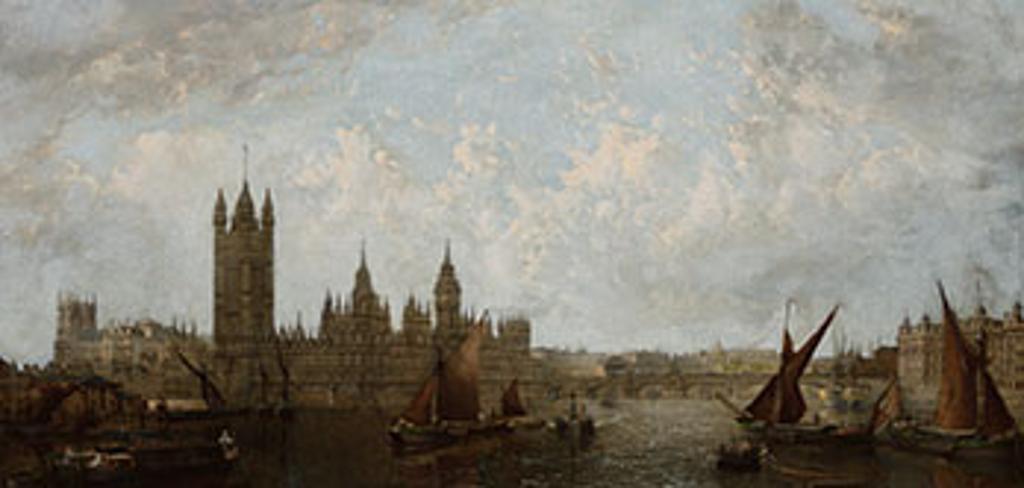
House of Parliament from the River Thames
30.5 cms x 61.6 cms (12 ins x 24.25 ins)
Signed, titled on the frame plate and dated 1873 and on verso inscribed indistinctly on a label and on the stretcher
made in 1873
Lot offered for sale by Heffel, Vancouver at the auction event "International & Canadian Art online sales, October 4 - 25, 2018 Online auction" held on Thu, Oct 25, 2018.
Lot 201
Lot 201
Estimate: CAD $10,000 - $15,000
Realised: CAD $10,000
Realised: CAD $10,000
Lot description - from the online catalogue*
Provenance:
N.R. Omell, London, United Kingdom
Acquired from the above by John Hampton Hale, Montreal, January 9, 1970
Estate of Nancy Ryrie Birks Hale, Montreal
Notes:
John MacVicar Anderson was born in Glasgow in 1835 from a family of merchants. In 1851, he moved to London to become an apprentice at his Uncle William Burn’s architecture practice. Burn was a notable Scottish Architect and a pioneer of the Scottish Baronial style. He became an Associate of the Royal Institute of British Architects in 1864 and became its Honorary Secretary from 1881 to 1889 before being elected President in 1891.
Throughout his career, Anderson designed several country houses, and accepted many important commissions for commercial and ecclesiastical buildings. As RIBA’s Honorary Secretary, he campaigned against the demolition of architect James Gibbs’ St Mary le Strand church in London and was later appointed architect for its restoration.
Anderson was also a skilful painter, and his active involvement in the conservation of British architectural heritage is reflected in his paintings, such as in this remarquable view the Palace of Westminster as seen from the South side of the River Thames. This view of the Palace of Westminster, which Anderson painted multiple times, pays tribute to architect Charles Barry’s chef-d’oeuvre, which is seen by many as a height of Gothic Revival architecture.
For advocates of Gothic revivalism, Charles Barry’s design for the Westminster Palace was an exemplary architectural achievement that masterfully conciliated architectural innovations, such as the use of cast-iron structure, with an informed knowledge of the English Gothic architectural vocabulary. At the time of its completion in 1858, the Victoria Tower, which stands majestically at the left side of the Palace in the present composition, was the tallest secular building in the world.
Anderson’s extreme attention to details and outstanding drawing skills are superbly exemplified in the present work. With the traditional sailing barges on the River Thames and their distinctive ochre sails, the Westminster Bridge and the Gothic Westminster Abbey in the foreground, this view conveys a sense of great architectural harmony and unity. House of Parliament from the River Thames shows much similarities with another composition by Anderson entitled View of Westminster from the Thames (Sold, Sale of Christies, November 25, 2003, Lot 154).
N.R. Omell, London, United Kingdom
Acquired from the above by John Hampton Hale, Montreal, January 9, 1970
Estate of Nancy Ryrie Birks Hale, Montreal
Notes:
John MacVicar Anderson was born in Glasgow in 1835 from a family of merchants. In 1851, he moved to London to become an apprentice at his Uncle William Burn’s architecture practice. Burn was a notable Scottish Architect and a pioneer of the Scottish Baronial style. He became an Associate of the Royal Institute of British Architects in 1864 and became its Honorary Secretary from 1881 to 1889 before being elected President in 1891.
Throughout his career, Anderson designed several country houses, and accepted many important commissions for commercial and ecclesiastical buildings. As RIBA’s Honorary Secretary, he campaigned against the demolition of architect James Gibbs’ St Mary le Strand church in London and was later appointed architect for its restoration.
Anderson was also a skilful painter, and his active involvement in the conservation of British architectural heritage is reflected in his paintings, such as in this remarquable view the Palace of Westminster as seen from the South side of the River Thames. This view of the Palace of Westminster, which Anderson painted multiple times, pays tribute to architect Charles Barry’s chef-d’oeuvre, which is seen by many as a height of Gothic Revival architecture.
For advocates of Gothic revivalism, Charles Barry’s design for the Westminster Palace was an exemplary architectural achievement that masterfully conciliated architectural innovations, such as the use of cast-iron structure, with an informed knowledge of the English Gothic architectural vocabulary. At the time of its completion in 1858, the Victoria Tower, which stands majestically at the left side of the Palace in the present composition, was the tallest secular building in the world.
Anderson’s extreme attention to details and outstanding drawing skills are superbly exemplified in the present work. With the traditional sailing barges on the River Thames and their distinctive ochre sails, the Westminster Bridge and the Gothic Westminster Abbey in the foreground, this view conveys a sense of great architectural harmony and unity. House of Parliament from the River Thames shows much similarities with another composition by Anderson entitled View of Westminster from the Thames (Sold, Sale of Christies, November 25, 2003, Lot 154).
Most realised prices include the Buyer's Premium of 18-25%, but not the HST/GST Tax.
(*) Text and/or Image might be subject matter of Copyright. Check with Heffel auction house for permission to use.
(*) Text and/or Image might be subject matter of Copyright. Check with Heffel auction house for permission to use.